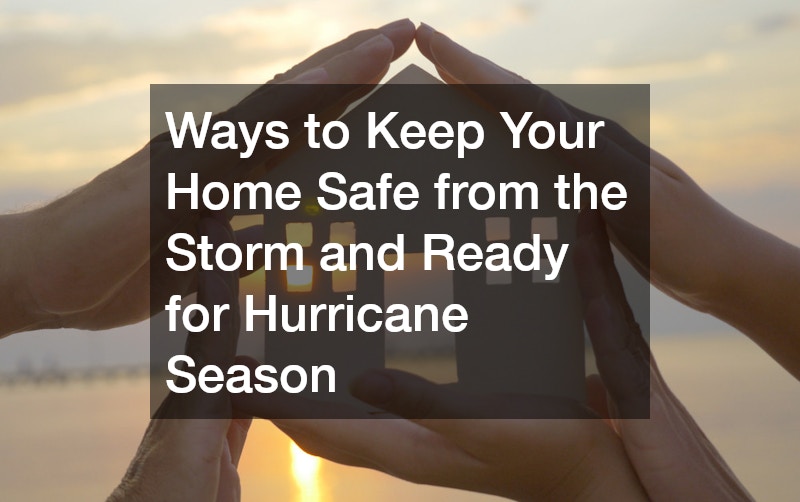Each year, hurricane season brings with it powerful storms, heavy rainfall, and strong winds that can devastate homes and communities. As climate change continues to influence weather patterns, the intensity and frequency of these storms have grown, making preparation more important than ever. If you live in a coastal region or an area prone to hurricanes, being proactive can make all the difference when it comes to keeping your home and family safe from the storm.
Securing your property involves more than boarding up windows at the last minute or rushing to the store for emergency supplies. True storm readiness requires thoughtful planning and investment in the structure and systems of your home. From impact doors and replacement windows to proper insulation and roofing, each element plays a critical role in reducing damage and increasing resilience.
In this comprehensive guide, we’ll walk you through 12 essential ways to protect your home before hurricane season peaks. You’ll learn how to make your property more resistant to water damage, wind infiltration, and flooding. We’ll cover both structural reinforcements and operational strategies, showing you how each layer of preparation contributes to keeping your home safe from the storm.
Whether it’s ensuring your gutters are clear, your garage door is reinforced, or your AC and plumbing systems are up to the challenge, there are numerous smart actions you can take now. These upgrades not only protect your home but also increase its value and efficiency year-round. By the end of this guide, you’ll have a clear checklist to fortify your home and weather the season with confidence.
1. Reinforce

One of the first lines of defense in a storm is your home’s doors. Installing impact doors is a proactive way to keep your home safe from the storm. These specialized doors are constructed with reinforced materials and shatter-resistant glass to withstand flying debris and high winds. Unlike standard doors, impact doors are tested to meet rigorous storm safety standards, helping prevent structural damage and injury.
Beyond security, impact doors can offer better energy efficiency and sound insulation. When selecting doors for hurricane protection, look for those that meet or exceed local building codes. The doors should have sturdy frames, multiple locking mechanisms, and laminated glass that stays in place even if cracked.
Installing impact doors in all external entryways—including front, side, and patio doors—adds a crucial layer of protection. This small investment can pay off in safety and peace of mind during storm season. It’s a straightforward way to start your journey toward making your home truly safe from the storm.
2. Install
Windows are among the most vulnerable parts of any home during a hurricane. Strong winds can shatter unprotected glass, allowing rain and debris to enter. Upgrading to high-quality replacement windows designed for storm-prone areas is a key measure to keep your home safe from the storm.
Storm-resistant replacement windows are built with impact-resistant glass and heavy-duty frames. Some come with additional UV protection, energy efficiency, and sound dampening benefits. When shopping for windows, look for models that meet coastal and hurricane zone requirements, which typically include laminated glass layers that remain intact upon impact.
Proper installation is just as critical as the product itself. Even the most durable window can fail if not installed correctly. Hiring professionals ensures your replacement windows will perform under pressure. This upgrade enhances not only your storm readiness but also the aesthetic and resale value of your home. Being proactive here means your home is more secure and more efficient, all while remaining safe from the storm.
3. Maintain
Gutters play a vital role in channeling rainwater away from your home’s foundation. When they’re clogged or damaged, water can pool and seep into walls, roofs, and basements. That’s why regular inspections and timely gutter replacement are essential steps in staying safe from the storm.
New, properly installed gutters help manage large volumes of water and prevent flooding. Choose materials like aluminum or copper that resist rust and corrosion. Seamless gutters reduce the chance of leaks, while gutter guards can minimize debris buildup.
If your gutters sag, overflow, or show signs of wear, don’t wait for a storm to test their limits. Hiring professionals for a gutter replacement ensures that your drainage system is functional and efficient. This small yet significant upgrade can save thousands in water damage repairs and help you stay safe from the storm when the next hurricane hits.
4. Inspect

Your roof is the shield that protects your entire home. During hurricane season, it must endure high winds, heavy rain, and even falling branches. Working with experienced roofing companies to inspect and reinforce your roof can help keep your home safe from the storm.
Start with a thorough inspection to identify loose shingles, damaged flashing, or soft spots. A reputable roofing company can assess your roof’s structural integrity and recommend necessary repairs or upgrades. In some cases, a full roof replacement might be the best option, especially if your current roof is over 20 years old.
Modern roofing materials like asphalt shingles with reinforced fiberglass or metal roofing panels are both strong and wind-resistant. Don’t overlook the importance of roof decking, underlayment, and fasteners—all play a role in keeping your roof intact during a hurricane.
Investing in these improvements through trusted roofing companies ensures your roof stands strong against the elements. With the right steps, your home will be better equipped to remain safe from the storm.
5. Seal
Many homeowners overlook insulation when preparing for hurricane season, but insulation companies know its hidden importance. Good insulation helps seal your home, preventing wind-driven rain from penetrating walls and ceilings. It also helps stabilize your indoor climate, particularly if power is lost during a storm.
Insulation creates a moisture barrier that reduces mold growth and structural damage. Closed-cell spray foam is a popular choice in storm-prone areas because it fills cracks and hardens, adding structural strength. It can also reduce energy costs and sound transmission.
By consulting with professional insulation companies, you can ensure that your attic, crawl spaces, and walls are properly protected. These upgrades can make your home more energy efficient and storm-resilient. Effective insulation keeps your family comfortable and safe from the storm, even when conditions outside become severe.
6. Secure
When storms strike, utility lines are often the first to go. Losing electricity or water access can turn a stressful situation into a dangerous one. Preparing your home’s utilities is a vital part of staying safe from the storm.
Start by securing backup power. Generators—either portable or whole-house systems—ensure that critical appliances like refrigerators, lights, and medical equipment continue to function. Check that fuel supplies are safe and that your generator is regularly tested.
You should also label and protect your home’s main electrical panel, water shutoff, and gas valves. Elevate any critical utilities if your home is in a flood-prone zone. Surge protectors help guard against electrical spikes, while battery-powered lighting offers backup during outages.
Simple precautions like these go a long way in maintaining safety and comfort. With the right preparations, your home can remain operational and safe from the storm, no matter what nature throws your way.
7. Fortify

Heavy rainfall and flooding can wreak havoc on your plumbing system. Working with plumbing companies before hurricane season ensures your pipes and drainage systems are up to code and ready to handle excess water.
Check for signs of corrosion, leaks, or backflow issues. Installing backwater valves and sump pumps can prevent sewage from backing up into your home. Flood-prone areas may benefit from elevating or sealing exposed plumbing.
In coastal regions, saltwater intrusion is another concern. Professional plumbing companies can help mitigate these risks and reinforce vulnerable points in your system. With a fortified plumbing infrastructure, you’ll be better positioned to keep your home safe from the storm.
8. Strengthen
Exterior stairs are often overlooked but are vulnerable to high winds and flooding. Loose steps or weak railings can become hazards during an evacuation or make your home more susceptible to damage. Reinforcing your exterior stairs is a proactive step to keep your property safe from the storm.
Use pressure-treated wood, composite materials, or concrete for stairs and railings that will endure heavy weather. Make sure fasteners are rust-resistant and that structural posts are anchored securely. If stairs are elevated, add support beams to increase stability.
Reinforced stairs improve both safety and accessibility, especially when wet or covered in debris. Taking these measures ahead of time ensures this key entry point won’t fail you, helping your home stay safe from the storm.
9. Prepare
Your HVAC system plays a critical role in comfort and safety, especially during summer storms. Prioritizing AC repair before hurricane season can help ensure your unit can withstand the weather and recover quickly after outages.
Have your system inspected for refrigerant leaks, faulty wiring, and clogged drains. Storms often bring humidity and moisture that strain HVAC systems. Securing the outdoor condenser unit with hurricane straps and elevating it off the ground can protect it from wind and flood damage.
A well-maintained AC system not only keeps your family comfortable but can prevent mold growth during post-storm humidity. Investing in professional AC repair now helps ensure your system runs efficiently and keeps your home safe from the storm.
10. Inspect

Slab leaks are hidden threats that can weaken your home’s foundation. Before hurricane season, inspect for signs like damp floors, high water bills, or low water pressure. Addressing slab leak repairs early can help keep your home safe from the storm.
Leaks under your home’s concrete slab can lead to serious structural issues if not caught in time. Flooding during a storm can exacerbate these weaknesses, making a bad situation worse. Professionals use acoustic and pressure testing to identify and fix leaks without destroying your flooring.
By handling slab leak repairs proactively, you’ll strengthen your home’s foundation and avoid costly post-storm repairs. It’s a quiet but crucial way to stay safe from the storm.
11. Reinforce
Garage doors are a large, often unreinforced point of entry for high winds. During a hurricane, failure here can lead to roof lift and major structural damage. Installing storm-rated residential garage doors is a smart step in making your home safe from the storm.
These doors feature reinforced tracks, strong panels, and wind-resistant bracing systems. Choose models rated for your area’s wind speeds and consider adding a vertical reinforcement kit. Professional installation ensures the door seals properly and operates smoothly.
With a reinforced garage door, your home’s biggest opening becomes a shield rather than a vulnerability. It’s a vital upgrade that provides safety, convenience, and peace of mind.
12. Final Checks
As hurricane season approaches, conducting a full home inspection and reviewing your emergency plans are final but essential steps. Schedule maintenance for major systems, restock emergency supplies, and confirm evacuation routes with your family. These actions help keep everyone safe from the storm.
Walk around your home to inspect trees, fences, and loose items in the yard. Trim branches and secure outdoor furniture. Make sure your windows and doors are labeled and that storm shutters function properly. Keep critical documents in a waterproof container and charge all communication devices.
Revisit your insurance policies to ensure proper coverage. Take photos of your home’s interior and exterior for record-keeping. Share your storm plan with neighbors and have a checklist ready for when the warning comes. These final preparations tie everything together, ensuring you’re fully equipped to handle whatever hurricane season brings.
Preparing your home for hurricane season is more than a checklist—it’s a commitment to your safety, your family’s well-being, and the long-term value of your property. From structural upgrades like impact doors and replacement windows to critical systems maintenance through roofing and plumbing companies, each measure adds resilience. By working with experts and taking a proactive approach, you build a layered defense that keeps you safe from the storm.
Every detail matters—from the gutters and garage door to insulation and slab leak repairs. Even small upgrades like reinforcing exterior stairs or investing in AC repair make a significant impact. And while some improvements may seem costly upfront, they can save thousands in emergency repairs and insurance claims later.
Emergency readiness is just as important. Securing utilities, reviewing insurance, stocking supplies, and finalizing an evacuation plan ensure you’re not just safe from the storm, but ready to recover quickly.
Hurricane season is unpredictable, but your preparation doesn’t have to be. Use this guide to identify your home’s vulnerabilities, address them methodically, and build a safer, stronger future. With the right steps today, your home can withstand whatever the next storm brings.




